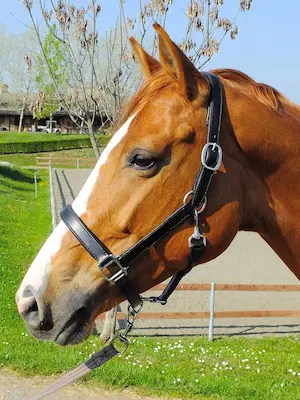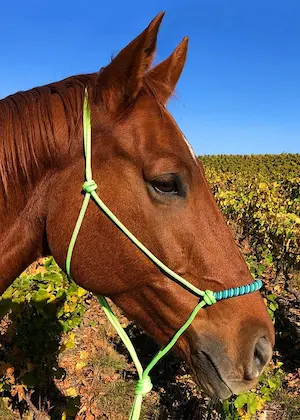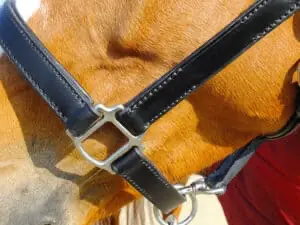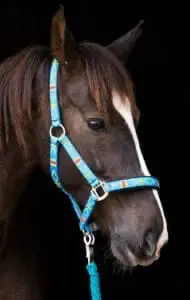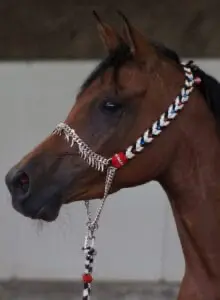Whether we realize it or not a halter is probably one of the most important (if not the most important) pieces of kit any horse owner will ever have. It can be a fashion statement, can be used to identify a horse, as a valuable training aid, or as an integral part of showing success but most crucially it’s used to keep your horse safe and secure.
When buying a new halter it’s vital that it fits the horse properly but beyond that, there’s a vast array of options out there, from the type of material you opt for to the choice of color, on top of that you also need to consider what you’ll be using it for. If you’re not sure what’s best for you and your horse though don’t worry this helpful guide will give you all of the information you need to make the right choice.
What you need to consider before buying a halter
Before you rush out and buy a new halter there are a few things that you need to consider first, after all a poorly fitted halter or an inappropriately used one can cause pain and discomfort to your horse and, in some cases can result in behavioral issues.
How does the halter fit your horse?
At best a badly fitting halter just won’t do its job properly but it’s also likely to cause a great deal of pain to your horse over time, either by pinching him or by rubbing against his very sensitive and thin facial skin. The noseband on a well-fitted halter will sit around an inch (approximately two finger widths) below the cheekbone, too high and there’s a risk of it catching your horse in the eye, but too low and it can put pressure on his nose and restrict his breathing.
Halters that are too big will move around a lot and could possibly damage your horse’s eyes, especially if any of the metal buckles or fastenings get near them. On the other hand, though, a halter that’s too small can rub and punch your horse, causing permanent scarring as well as, in some extreme cases, bone damage.
A halter shouldn’t be a substitute for good training
While many people use halters to train their horses they should never be used as a substitute for good training. If your horse isn’t halter trained already then take time to train him yourself in his stall, start by using a lightweight halter and allow him to investigate it first before you try and put it on him. The key is to be patient and give him time to get used to the pressure that it applies first.
If you’re not sure how to train a horse properly a more severe halter won’t make up for this, instead speak to a professional beforehand. Every single trainer has had to learn at some point so there’s no shame in asking for help, but there is shame in allowing your horse to suffer because you won’t ask for any help.
What materials are halters made from?
Halters can be made from a variety of different materials, each with its own benefits and drawbacks.
Leather is the most popular material for halters
Traditionally halters have always been made of leather and while, for many years, this was the only alternative it’s still a very good material that can, if looked after properly, last a lifetime. That said though not all leathers are the same and a good quality English bridle leather halter while being more expensive than one made from cowhide, will be far more durable.
When it comes to show halters they can be highly decorative plain leather with intricate tooling and fancy stitching or patent leather. On the other hand, though, they can also be toughened for outdoor/turnout use with double or triple stitching. If your horse needs to be turned out while wearing a halter then leather is the ideal choice because, although it’s very tough, it will break if your horse gets it caught.
One of the things that some people don’t like about leather halters is that they need to be looked after and cleaned in the same way you do the rest of your tack. This will not only help them to last longer but will also keep them safe for your horse. If you don’t maintain the leather properly then it’ll start to dry and become brittle, this could cause it to crack and therefore be hazardous to your horse.
Sizes: Foal, pony, cob, horse (or full), and oversized.
Pros: Fully adjustable, breakable, durable, available in a range of styles.
Cons: Expensive, needs to be maintained, can crack if not looked after.
Nylon is strong and virtually unbreakable
Any halter that isn’t made from leather or rope is typically referred to as nylon although it can be made from a range of synthetic fabrics such as nylon and polypropylene. The fabric is woven into layers (known as ply) that make the halter durable, long-lasting, and extremely tough. Typically they come with either one, two, or three layers which will determine just how strong they are, with single-ply halters being the weakest.
Unlike leather halters that are only available in a few colors (normally just natural colors such as brown, black, or tan), nylon halters can literally be found in any color you can think of, and probably a few you hadn’t even thought of!
Nylon halters are very popular because not only are they cheap, they don’t need a huge amount of looking after apart from an occasional hosing down. In fact, they’re so cheap that, even if you prefer not to use them on a day-to-day basis, you should still keep one as a backup halter in case you lose your regular one or it breaks.
One of the main selling points of nylon is that it’s ‘practically unbreakable’ and can’t be cut either, this might seem like a good thing in everyday life, but when it comes to halters it’s the one thing that actually makes a nylon halter a bad choice. If your horse gets his halter caught and can’t free himself no amount of pulling will break it.
Sizes: Foal, mini, pony, cob, horse (or full), draft, and oversized.
Pros: Cheap, durable, available in any color, easy to maintain.
Cons: Won’t break in an emergency, shouldn’t be used for turnout.
Rope halters are becoming more common
Made from a single piece of rope that’s knotted strategically, they’ve been a popular choice amongst Western riders for many years and are becoming more and more popular with English riders too. They can be made from cotton or a range of synthetic materials such as polypropylene and are available ready-made, in kit form or you can make them yourself (although if you’ve never made one before I wouldn’t recommend this).
The thickness of the rope can make a big difference in the use and effectiveness of a rope halter. A thinner rope will apply more pressure to the horse’s sensitive areas and can be useful for handling difficult horses, whereas a thicker rope will apply more even pressure and can be used on horses that are easy to lead (or are too sensitive for a thinner rope). Regardless of the thickness of the rope they still apply more pressure than leather and nylon halters so if you’re using one you’ll need to be gentle with your hands
The knots on the halter are designed to apply pressure to the horse with some halters having multiple knots along the noseband, although these are more extreme so should only be used by experienced handlers or trainers.
They’re fully adjustable so one halter can be adjusted to fit any horse but because, like nylon, they won’t break you shouldn’t turn your horse out while he’s wearing a rope halter. They also can’t be used with crossties because their design means there’s nowhere to attach the clips.
Sizes: One size fits all.
Pros: Fully adjustable with no metal parts, lightweight, cheap.
Cons: Can be hard to fit properly, too harsh for some horses, and won’t break.
Additional options to consider when buying a halter
The type of material you opt for isn’t the only choice you have when it comes to your new halter, there are a number of other things you need to consider too.
Rolled
While it’s mainly rope halters that are rolled, some leather ones are also made of thin rolled leather but unlike flat halters, they apply a more acute pressure instead of evenly distributing it. This can be good for horses that need a firmer hand but conversely, if your horse is easy to lead then they can apply unnecessary pressure which in some cases can panic the horse.
Flat
The majority of leather and nylon halters are made from flat bands that, in the case of leather can be folded, or layered as is the case with nylon halters. This makes them very comfortable for the horse because they lie flat against their face and cover a wide area, this means that they’re applying a more even pressure. Some flat halters will come with additional padding under the bands that distributes the pressure even more.
Metal parts
Unless you’re using a rope halter the chances are that your halter will have a variety of metal parts that can make putting it on your horse (and removing it quickly) easier but can also be used to attached crossties and lead ropes too.
- Side clips – As the name suggests these are positioned on the sides of the halter (usually where the noseband and chin piece meet) and can be used for attaching crossties.
- Tie ring – Some halters have a fixed tie ring (which is in the middle of the chin piece) while others have a ring that can move freely, whichever of these your halter has it’s used to tie a horse up with and can also be used to clip lead ropes too.
- Snap – More common with leather halters, this is a clip that attaches the throat latch to the cheek and crown pieces. This normally means that the throat latch can be removed, useful for things like grooming and bathing.
Personalized halters
Some halters come with a plaque on the cheekpiece that can be engraved with your horse’s name, or if yours doesn’t you can buy plaques, have them engraved, and then secure them to the cheekpiece yourself. Nylon halters can also have personalized stitching (either in a specific pattern or your horse’s name) along the noseband and or cheekpiece.
Different types of halter
While most halters can be used for multiple purposes there are some that have specific uses or have features that make them different from ’standard’ halters.
Breakaway
There are a few different designs of breakaway halters but they all work in the same way and that is to allow nylon halters to break when under stress, making them suitable for turnout use. The main designs are:
- Breakable crown piece – There are two main types of breakable crown pieces, those that are leather so will naturally break or those that are nylon but with a weaker ‘breakpoint’.
- Leather cheek strap – Similar to the leather crown piece these breakaways have replaced the nylon cheek strap with one made of leather that will break if they’re put under pressure.
- Velcro – Typically breakaway halters with velcro are made completely of nylon but have the crown piece or cheek strap (or both) fastened with velcro. This means that they will break when they needed but can also be put back together and used again.
Training
Sometimes called a pressure halter, these are designed specifically for training a horse and not for anything else. They work by applying pressure to the horse’s nose (and sometimes the poll) when they pull away from the handler. The second the horse stops the pressure is released, therefore teaching the horse that the best place to be is with the handler. There are a few different styles of pressure halter but probably the best one is known as a dually halter and was designed by Monty Roberts.
Padded
I don’t really think this needs too much explaining and the name is pretty self-explanatory. The padding, which can be fleece or sheepskin, is normally around the nose and poll but can also cover the cheek straps too. It can be great for sensitive horses because the pressure is softer and distributed over a bigger area. The drawback to padded halters though is that not only do they get very hot in the summer but they can also be difficult to keep clean.
Grooming
These normally consist of just a noseband that’s attached to the crown piece but they, in some cases, be regular halters that have removable straps. They offer little in the way of control but are good at allowing you easy access to the face while grooming or washing your horse.
Transport (or shipping)
Similar to padded halters, these are designed especially to give the horse extra comfort while being transported. They’re padded all the way around and will prevent sores from developing if the horse leans into them while on the move.
Show (or decorative)
Thinner than most halters they’re designed to help show off a horse’s best assets and can be highly decorated with gold, silver, and gems. They can also be engraved and have detailed tooling on them. The main drawback to show halters though is the cost, especially if you opt for gold or silver embellishments and gemstones.
Combination
Sometimes known as trail or packer bridles these are ideal for trail riders who need a quick way to change between a bridle and a halter. Combination halters have adjustable straps that hold the bit in place when riding but can easily be removed when you’ve finished.
I hope you found this article helpful. If you did I’d be grateful if you could share it please as it would really help me.
Recommended products
Over the years I have tried hundreds of different horsey products, from various blankets and halters to different treats. Some I’ve loved, others I’ve hated but I thought I’d share with you my top all-time favorite products, the ones I never leave the yard without. I’ve included links to the products (which are in no particular order) that I really think are great.
- Horse Knots by Reference Ready – If you’re like me and enjoy pocket reference guides then you’ll love this knot tying guide. These handy cards can easily fit in your pocket or attach to the saddle for quick reference. They’re waterproof, durable and are color coded to make them easy to follow.
- Mane ’n Tail Detangler – Even if you never show your horse you’ll need to detangle his tail from time to time (and possibly his mane too) which is always a challenging chore! I’ve found that if I run a little bit of detangler through my horse’s tails every few days it stops them from getting matted up and makes combing them easy, even if they’re coated in mud. I don’t know if I should admit to this or not but it also works wonders on my hair.
- TAKEKIT Pro clippers – Over the years I’ve tried a lot of different clippers and while some were obviously better than others I found these to be by far the best. They are heavier than a lot of other clippers but for me, that’s a good thing, it makes them feel more sturdy and hardwearing. On top of that they have a range of speeds so are just as good for clipping your horse’s back as they are his face. I also like the fact that they come in a handy carry case but that’s not for everybody. The company that makes them is super good and incredibly helpful too, a real bonus these days. The only thing I wasn’t keen on was the fact that it doesn’t come with any oil, but that’s not a major problem as it’s not difficult to buy lubricant.
- Shire’s ball feeder – There are so many boredom buster toys out there but I like to use these every day, regardless of whether or not my horses are bored. I find that it helps to encourage my horses to problem solve by rewarding them with treats (or pieces of fruit) but it also mimics their natural grazing behavior which helps to keep them calm and de-stressed.
- Horse safe mirror – This is a strange one that many people are surprised about but I like to put horse safe mirrors in the trailers as well as in the quarantine stalls. It helps to prevent the feeling of isolation by giving the impression of other horses being around. Being herd animals horses can get extremely stressed when they feel that they’re on their own but with these stick-on mirrors, they believe that at least one other horse is with them.
- Rectal thermometer – I know this isn’t glamourous at all but it’s vital for your horse’s well-being to be able to check their temperature and a rectal thermometer is the easiest way of doing this which is why I’ve added it to the list.
Shopping lists
I’ve also put together a few shopping lists of essential items that I’ve found helpful over the years. I’ve broken the lists down into different categories rather than put everything in one massive list 😉


